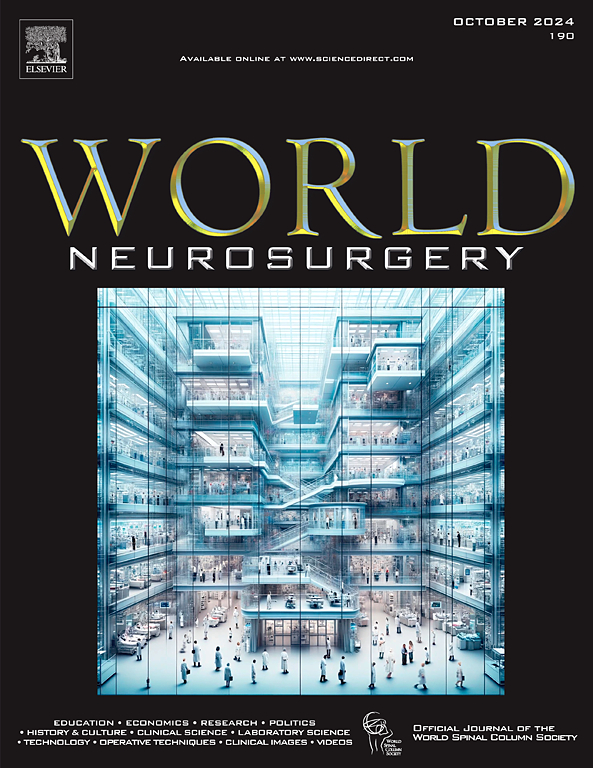Elevated Admission N-Terminal Pro-Brain Natriuretic Peptide as a Predictor of Computed Tomography Perfusion Core Infarct Overestimation in Acute Ischemic Stroke in a Sample of Chinese Patients
IF 1.9
4区 医学
Q3 CLINICAL NEUROLOGY
引用次数: 0
Abstract
Background
Overestimation of computed tomography perfusion (CTP) core infarcts in ischemic stroke is common and may interfere with treatment decisions. We aim to assess the value of admission N-terminal pro-brain natriuretic peptide (NT-pro BNP) in predicting CTP core infarct overestimation.
Methods
A total of 353 patients with anterior circulation large vessel occlusion stroke who achieved satisfactory recanalization (extended thrombolysis in cerebral infarction ≥ 2c) from a single-center prospective database were enrolled in this study. Core infarct overestimation was considered when the CTP-derived infarct was larger than the final infarct measured on 24- to 48-hour noncontrast CT. Multivariable logistic regression analysis was performed to identify variables associated with overestimation.
Results
Fifty-two (14.8%) patients presented with CTP core infarct overestimation. Multivariate analysis, adjusted for covariates, showed that admission NT-pro BNP (adjusted odds ratio [OR] 1.34; 95% confidence interval [CI] 1.13–1.69), poor collaterals (adjusted OR 3.13; 95% CI 1.87–4.87), onset-to-imaging time (adjusted OR 0.23; 95% CI 0.17–0.46), and embolism etiology (adjusted OR 1.15; 95% CI 1.09–1.46) were independently associated with overestimation. Based on the receiver operating characteristic curve, the optimal cut-off value of NT-pro BNP for diagnosing infarct overestimation was 876 pg/ml, which yielded a sensitivity of 76.9%, a positive likelihood ratio of 2.796, a negative likelihood ratio of 0.319, and an area under the curve of 0.813 (95% CI: 0.761–0.864).
Conclusions
Elevated admission NT-pro BNP could serve as a predictor of CTP infarct overestimation. CTP results should be interpreted with caution in specific circumstances to ensure that patients who might benefit from thrombectomy are not inadvertently excluded.
入院NT-pro BNP升高作为急性缺血性卒中CT灌注核心梗死高估的预测因子。
背景:在缺血性脑卒中中,高估CT灌注(CTP)核心梗死是常见的,并可能干扰治疗决策。我们的目的是评估入院n端前脑利钠肽(NT-pro BNP)在预测CTP核心梗死高估中的价值。方法:从单中心前瞻性数据库中共纳入353例前循环大血管闭塞卒中患者,这些患者获得了满意的再通(脑梗死≥2c时延长溶栓)。当ctp衍生的梗死大于24至48小时非对比CT测量的最终梗死时,考虑核心梗死高估。进行多变量logistic回归分析以确定与高估相关的变量。结果:52例(14.8%)患者出现CTP核心梗死高估。多因素分析,调整协变量,显示入院NT-pro BNP(调整OR 1.34;95% CI 1.13-1.69),不良抵押品(调整OR 3.13;95% CI 1.87-4.87),发病至成像时间(调整OR 0.23;95% CI 0.17-0.46),栓塞病因学(调整OR 1.15;95% CI 1.09-1.46)与高估独立相关。基于受试者工作特征曲线,NT-pro BNP诊断梗死高估的最佳临界值为876 pg/ml,敏感性为76.9%,阳性似然比为2.796,阴性似然比为0.319,曲线下面积为0.813 (95% CI: 0.761 ~ 0.864)。结论:入院时NT-pro BNP升高可作为CTP梗死高估的预测因子。CTP结果应在特定情况下谨慎解释,以确保可能受益于血栓切除术的患者不会被无意中排除。
本文章由计算机程序翻译,如有差异,请以英文原文为准。
求助全文
约1分钟内获得全文
求助全文
来源期刊

World neurosurgery
CLINICAL NEUROLOGY-SURGERY
CiteScore
3.90
自引率
15.00%
发文量
1765
审稿时长
47 days
期刊介绍:
World Neurosurgery has an open access mirror journal World Neurosurgery: X, sharing the same aims and scope, editorial team, submission system and rigorous peer review.
The journal''s mission is to:
-To provide a first-class international forum and a 2-way conduit for dialogue that is relevant to neurosurgeons and providers who care for neurosurgery patients. The categories of the exchanged information include clinical and basic science, as well as global information that provide social, political, educational, economic, cultural or societal insights and knowledge that are of significance and relevance to worldwide neurosurgery patient care.
-To act as a primary intellectual catalyst for the stimulation of creativity, the creation of new knowledge, and the enhancement of quality neurosurgical care worldwide.
-To provide a forum for communication that enriches the lives of all neurosurgeons and their colleagues; and, in so doing, enriches the lives of their patients.
Topics to be addressed in World Neurosurgery include: EDUCATION, ECONOMICS, RESEARCH, POLITICS, HISTORY, CULTURE, CLINICAL SCIENCE, LABORATORY SCIENCE, TECHNOLOGY, OPERATIVE TECHNIQUES, CLINICAL IMAGES, VIDEOS
 求助内容:
求助内容: 应助结果提醒方式:
应助结果提醒方式:


